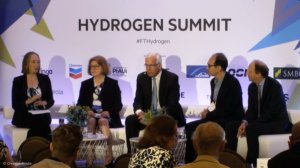Produce local green hydrogen in hot South Africa to add value to iron-ore, FT Hydrogen Summit hears

FT Hydrogen Summit covered by Mining Weekly’s Martin Creamer. Video: Darlene Creamer.
JOHANNESBURG (miningweekly.com) – As iron-ore mining in South Africa, West Africa, the Pilbara, and Brazil happen to be hot and windy places, it makes a lot of sense for the global south to produce green hydrogen on site to reduce, deoxidise and pelletise iron-ore into an added-value product that can be shipped more efficiently.
Doing so will achieve for the global south the added value that the crude oil industry never delivered, the classic example being Nigeria, where crude oil is produced and sold for petrodollars and then reimported back into the country at five times the crude oil price, CWP Global strategy head Tom Dimitroff told the FT Hydrogen Summit covered by Mining Weekly. (Also watch attached Creamer Media video.)
“The same thing applies in the case of maritime bunker fuel. You’re not going to produce green hydrogen, ship it to Rotterdam and then have ships load it at Rotterdam. Basically, you co-locate refuelling stations approximate to that,” Dimitroff commented.
In terms of policy initiatives, the global north had, he said, been hugely responsive, with some 16 countries coming forward with policies and 700 green hydrogen projects. Backed by last year’s Inflation Reduction Act (IRA) announcement, green hydrogen projects are all set to proliferate further in the US.
“The US will satisfy a lot of its indigenous hydrogen offtake within the US itself – and they’ll have spare capacity to ship hydrogen.
“Another paradigm we need to look at is possible trading in electrolysers and other types of technology, and not just the trading of hydrogen.”
Platinum group metal-catalysed proton exchange membrane (PEM) electrolysers are used to produce green hydrogen and oxygen from water.
“We’re delighted with governments coming forward and starting to set firm prices that can catalyse decisions in the market – and the US IRA does that.
“I’m very much looking forward to other governments following suit, but on a more cooperative basis so there’s no zero-sum politics involved,” added Dimitroff.
AXE Group chairperson Christian Leysen, who is a member of the Chamber of Representatives of Belgium, also highlighted the advantage of on-site green hydrogen production to avoid transport costs.
“I think hydrogen will be best used when it is generated close to the industry using the hydrogen,” said Leysen.
EXPORTING GREEN HYDROGEN FROM SOUTH AFRICA
Oliver Rix, the energy partner of Baringa, a global consultancy focused on the energy transition, singled out the potential of South Africa, along with other countries like it, to produce and export green hydrogen effectively into Europe.
“But equally, if Europe can get its pipeline infrastructure right, then hydrogen can be moved from Iberia effectively into central Europe,” said Rix.
“If you start looking at the benefits that connecting hydrogen into electricity systems can provide, then that starts uncovering extra value.
“When you start looking at the potential renewables, the locations of demand and the potential for electrolysers to play a role in between those, then there is actually an economic case, even in a place like Japan,” added Rix.
In the UK, hydrogen is seen as a commodity able to generate considerable economic growth: “It was only when in 2019, when we did the report looking at how we get to net zero that suddenly we needed hydrogen. So, we are talking about the last 20% of decarbonisation," said Baroness Brown, a Cambridge House of Lords crossbench member.
“When you look at that, even in the UK, it means an amount of energy from hydrogen that’s approaching the scale of the electricity system that we have today. That’s building a big industry. Even if you halve the numbers, it’s a big requirement,” the baroness added.
Article Enquiry
Email Article
Save Article
Feedback
To advertise email advertising@creamermedia.co.za or click here
Press Office
Announcements
What's On
Subscribe to improve your user experience...
Option 1 (equivalent of R125 a month):
Receive a weekly copy of Creamer Media's Engineering News & Mining Weekly magazine
(print copy for those in South Africa and e-magazine for those outside of South Africa)
Receive daily email newsletters
Access to full search results
Access archive of magazine back copies
Access to Projects in Progress
Access to ONE Research Report of your choice in PDF format
Option 2 (equivalent of R375 a month):
All benefits from Option 1
PLUS
Access to Creamer Media's Research Channel Africa for ALL Research Reports, in PDF format, on various industrial and mining sectors
including Electricity; Water; Energy Transition; Hydrogen; Roads, Rail and Ports; Coal; Gold; Platinum; Battery Metals; etc.
Already a subscriber?
Forgotten your password?
Receive weekly copy of Creamer Media's Engineering News & Mining Weekly magazine (print copy for those in South Africa and e-magazine for those outside of South Africa)
➕
Recieve daily email newsletters
➕
Access to full search results
➕
Access archive of magazine back copies
➕
Access to Projects in Progress
➕
Access to ONE Research Report of your choice in PDF format
RESEARCH CHANNEL AFRICA
R4500 (equivalent of R375 a month)
SUBSCRIBEAll benefits from Option 1
➕
Access to Creamer Media's Research Channel Africa for ALL Research Reports on various industrial and mining sectors, in PDF format, including on:
Electricity
➕
Water
➕
Energy Transition
➕
Hydrogen
➕
Roads, Rail and Ports
➕
Coal
➕
Gold
➕
Platinum
➕
Battery Metals
➕
etc.
Receive all benefits from Option 1 or Option 2 delivered to numerous people at your company
➕
Multiple User names and Passwords for simultaneous log-ins
➕
Intranet integration access to all in your organisation















